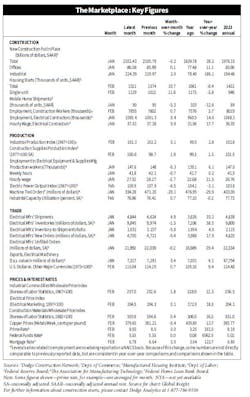Latest from Construction Industry
Latest from Construction Industry
Photo_87684009 / Sculpies / Dreamstime
Electrical Marketing Leading Indicators - March 22, 2024 Update
March 22, 2024
Building permits rise modestly in January
According to the U.S. Census Bureau, single‐family authorizations in February were at a rate of 1,031,000, +1% above the revised January figure of 1,021,000. Authorizations of units in buildings with five units or more were at a rate of 429,000 in February.
AIA Billings Index shows February pickup in inquiries
Architecture firm billings continued to decline in February, with an AIA/Deltek Architecture Billings Index (ABI) score of 49.5 points for the month. However, February’s score marks the most modest easing in billings since July 2023 and suggests that the recent slowdown may be receding.
“There are indicators this month that business conditions at firms may finally begin to pick up in the coming months. Inquiries into new projects grew at their fastest pace since November, and the value of newly signed design contracts increased at their fastest pace since last summer,” said Kermit Baker, chief economist, for the American Institute of Architects. “Given the moderation of inflation for construction costs and prospects for lower interest rates in the coming months, there are positive signs for future growth.”
The ABI score is a leading economic indicator of construction activity, providing an approximately nine-to-twelve-month glimpse into the future of nonresidential construction spending activity. The score is derived from a monthly survey of architecture firms that measures the change in the number of services provided to clients.
Conference Board's U.S. Leading indicators reveal some rays of hope
The Conference Board Leading Economic Index (LEI) for the U.S. fell by -0.4% in Jan. 2024 to 102.7 (2016=100), following a -0.2% decline in December 2023.
Justyna Zabinska-La Monica, senior manager, Business Cycle Indicators, at The Conference Board, said in the press release, “While the declining LEI continues to signal headwinds to economic activity, for the first time in the past two years, six out of its ten components were positive contributors over the past six-month period. As a result, the leading index currently does not signal recession ahead. While no longer forecasting a recession in 2024, we do expect real GDP growth to slow to near zero percent over Q2 and Q3.”
Building permits rise modestly in January
According to the U.S. Census Bureau, single‐family authorizations in February were at a rate of 1,031,000, +1% above the revised January figure of 1,021,000. Authorizations of units in buildings with five units or more were at a rate of 429,000 in February.
AIA Billings Index shows February pickup in inquiries
Architecture firm billings continued to decline in February, with an AIA/Deltek Architecture Billings Index (ABI) score of 49.5 points for the month. However, February’s score marks the most modest easing in billings since July 2023 and suggests that the recent slowdown may be receding.
“There are indicators this month that business conditions at firms may finally begin to pick up in the coming months. Inquiries into new projects grew at their fastest pace since November, and the value of newly signed design contracts increased at their fastest pace since last summer,” said Kermit Baker, chief economist, for the American Institute of Architects. “Given the moderation of inflation for construction costs and prospects for lower interest rates in the coming months, there are positive signs for future growth.”
The ABI score is a leading economic indicator of construction activity, providing an approximately nine-to-twelve-month glimpse into the future of nonresidential construction spending activity. The score is derived from a monthly survey of architecture firms that measures the change in the number of services provided to clients.
Conference Board's U.S. Leading indicators reveal some rays of hope
The Conference Board Leading Economic Index (LEI) for the U.S. fell by -0.4% in Jan. 2024 to 102.7 (2016=100), following a -0.2% decline in December 2023.
Justyna Zabinska-La Monica, senior manager, Business Cycle Indicators, at The Conference Board, said in the press release, “While the declining LEI continues to signal headwinds to economic activity, for the first time in the past two years, six out of its ten components were positive contributors over the past six-month period. As a result, the leading index currently does not signal recession ahead. While no longer forecasting a recession in 2024, we do expect real GDP growth to slow to near zero percent over Q2 and Q3.”










